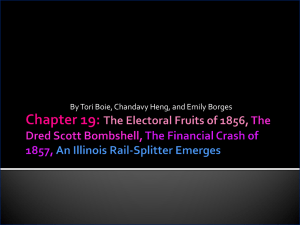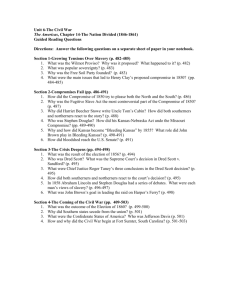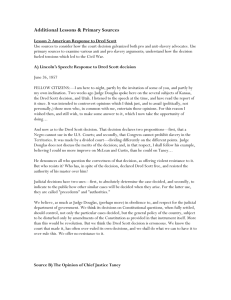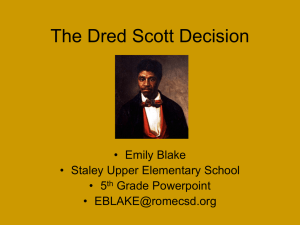Scott v. Sandford - Student Handout.doc
advertisement
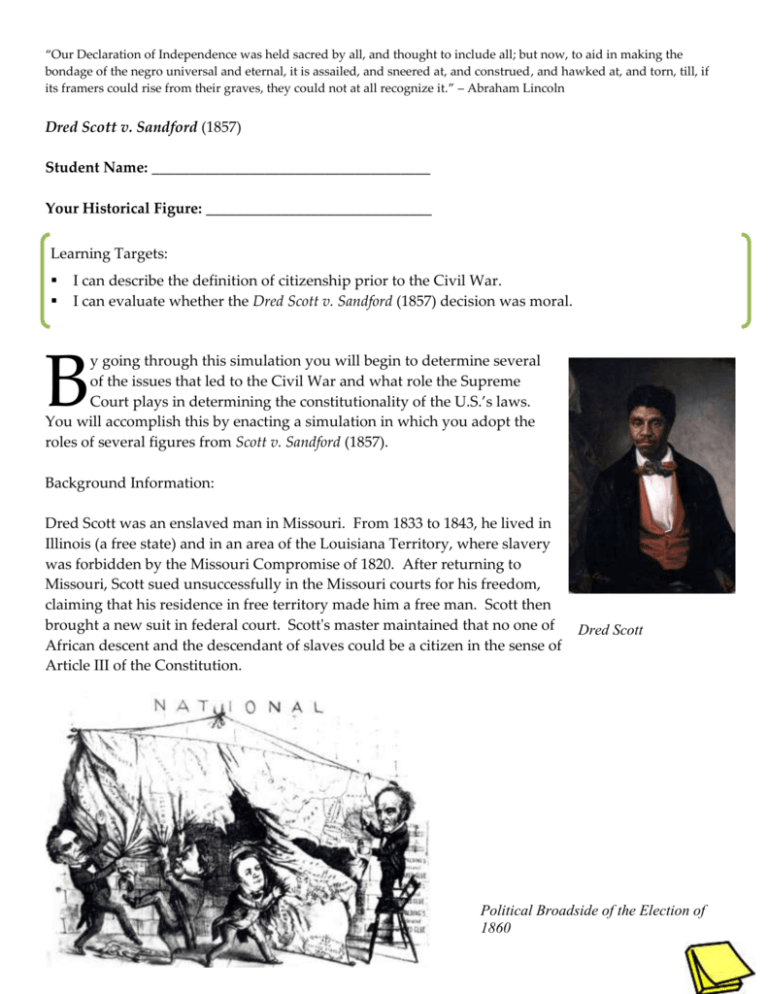
“Our Declaration of Independence was held sacred by all, and thought to include all; but now, to aid in making the bondage of the negro universal and eternal, it is assailed, and sneered at, and construed, and hawked at, and torn, till, if its framers could rise from their graves, they could not at all recognize it.” – Abraham Lincoln Dred Scott v. Sandford (1857) Student Name: _____________________________________ Your Historical Figure: ______________________________ Learning Targets: I can describe the definition of citizenship prior to the Civil War. I can evaluate whether the Dred Scott v. Sandford (1857) decision was moral. B y going through this simulation you will begin to determine several of the issues that led to the Civil War and what role the Supreme Court plays in determining the constitutionality of the U.S.’s laws. You will accomplish this by enacting a simulation in which you adopt the roles of several figures from Scott v. Sandford (1857). Background Information: Dred Scott was an enslaved man in Missouri. From 1833 to 1843, he lived in Illinois (a free state) and in an area of the Louisiana Territory, where slavery was forbidden by the Missouri Compromise of 1820. After returning to Missouri, Scott sued unsuccessfully in the Missouri courts for his freedom, claiming that his residence in free territory made him a free man. Scott then brought a new suit in federal court. Scott's master maintained that no one of African descent and the descendant of slaves could be a citizen in the sense of Article III of the Constitution. Dred Scott Political Broadside of the Election of 1860 I t is important to remember that this is a simulation of oral arguments in the Supreme Court and not a trial. No evidence is collected and no witnesses are called. The lawyers for both sides are simply putting forth their best legal arguments, and answering the questions that the justices have. Below are the roles and a brief description of who these people are. There will be the lawyers for Dred Scott and lawyers for John F.A. Sanford. There will also be nine Supreme Court Justices. The rest of the people will be politicians, abolitionists, or a court cartoonist. Dred Scott (Petitioner) – man attempting to sue for his freedom* John F.A. Sanford (Respondent) – Brother-in-law of Dr. John Chief Justice Roger B. Taney Emerson who was the original owner of Scott and is now deceased* Lawyers for Dred Scott – Montgomery Blair and George Ticknor Curtis Lawyers for John F.A. Sanford – Henry S. Geyer and Reverdy Johnson Roger B. Taney – Chief Justice of the Supreme Court Benjamin R. Curtis – Supreme Court Justice James M. Wayne – Supreme Court Justice John A. Campbell – Supreme Court Justice John Catron – Supreme Court Justice John McLean – Supreme Court Justice Peter V. Daniel – Supreme Court Justice Robert C. Grier – Supreme Court Justice Samuel Nelson – Supreme Court Justice James Buchanan, President-Elect of the United States* Republicans: Abraham Lincoln, William Seward, Charles Sumner Abolitionists: Frederick Douglass, William Lloyd Garrison, Harriet Tubman, Sojourner Truth, and Harriet Beecher Stowe Court Cartoonist *Dred Scott and John F.A. Sanford will not be at the trial; they are represented at the trial by their lawyers. President-Elect Buchanan will make a special appearance 2 Dred Scott v. Sandford (1857) – Precedent Cases & Etc. 1. What is a precedent? 2. Annotate each of the precedent cases/laws and create a one-sentence summary. Rachel v. Walker (1836), Missouri Supreme Court Missouri's case law prior to the Dred Scott case showed that in the cases where slave owners took slaves to free territory and then returned to the slave state, the slaves were actually emancipated (freed) upon arrival in the free state. This was based on an informal legal precedent called "comity" (one court recognizing the jurisdiction or authority of another.) This particular case determined that even a slave-holding officer residing on a military post in a free state was obligated to follow that state's rules. Source: http://lincoln.lib.niu.edu/teachers/lesson11group2 a. One-sentence Summary: U.S. v. The Amistad (1841), U.S. Supreme Court Case Kidnapped Africans were transported from Guinea to Cuba on a Portuguese slave ship in violation of Spanish laws forbidding the international slave trade. The slaves were sold to two Spaniards who were overpowered by the Africans while transporting them on the Amistad. The Africans were attempting to return to Africa, but the ship landed near Long Island, New York and they were taken to New London, Connecticut. The Supreme Court ruled in favor of the Africans stating that there was no evidence that the Africans were in fact slaves (they found that the documents that the Cubans had given La Amistad were falsified.) However, even though the Court did rule in the Africans favor, they did not use the language of the defense argument which stated that because the Africans were brought into the free states of New York and Connecticut they were legally free. Source: http://lincoln.lib.niu.edu/teachers/lesson11group2 b. One-sentence Summary: 3 Prigg v. Pennsylvania (1842), U.S. Supreme Court This case dealt with the constitutionality of personal liberty laws in free states. In this case Pennsylvania's 1826 law was used to prosecute a slave-catcher (Prigg) who had taken Margaret Moran to Maryland without the required "certificate of removal." The Supreme Court held that the Pennsylvania act was unconstitutional and that a master had the right to recapture runaway slaves based on common law or because of the fugitive-slave clause in the Constitution. Source: http://lincoln.lib.niu.edu/teachers/lesson11group2 c. One-sentence Summary: Handbill warning Boston’s black population Strader v. Graham (1851), U.S. Supreme Court In this case two slave musicians were taken into Ohio and then later escaped from Kentucky to Canada. The slave-owner captured them back and it was argued in court that they were freed the minute they set foot on free soil. The Kentucky Court of Appeals decided in favor of the slave-owner (it was really a suit for damages by the slave-owner against the men who had aided the slaves in their escape.) The Supreme Court dismissed the case stating it lacked jurisdiction (authority) because the Northwest Ordinance did not apply to Ohio because it was superseded by state law, thus the case did not present a federal question. Taney's opinion in this case outlined the idea that once the slaves were returned to Kentucky, Kentucky law applied and Ohio law could not be considered. Source: http://lincoln.lib.niu.edu/teachers/lesson11group2 d. One-sentence Summary: 4 Naturalization Act of 1802 Be it enacted by the Senate and House of Representatives of the United States of America in Congress assembled That any alien being a free white person may be admitted to become a citizen of the United States or any of them on the following conditions and not otherwise First That he shall have declared on oath or affirmation before the supreme superior district or circuit court of some one of the states or of the territorial districts of the United States . . . three years at least before his admission that it was . . . his intention to become a citizen of the United States and to renounce for ever [sic] all allegiance and fidelity to any foreign prince potentate state or sovereignty. . . . Secondly That he shall at the time of his application to be admitted declare on oath or affirmation before some one of the courts aforesaid that he will support the constitution of the United States and that he doth absolutely and entirely renounce and abjure all allegiance and fidelity to every foreign prince potentate state or sovereignty. . . . Thirdly That the court admitting such alien shall be satisfied that he has resided within the United States five years at least and within the state or territory where such court is at the time held one year at least and it shall further appear to their satisfaction that during that time he has behaved as a man of a good moral character attached to the principles of the constitution of the United States. . . . SEC 4 And be it further enacted That the children of persons duly naturalized under any of the laws of the United States or who previous to the passing of any law on that subject by the government of the United States may have become citizens of any one of the said states under the laws thereof being under the age of twenty one years at the time of their parents being so naturalized or admitted to the rights of citizenship shall if dwelling in the United States be considered as citizens of the United States and the children of persons who now are or have been citizens of the United States shall though born out of the limits and jurisdiction of the United States be considered as citizens of the United States provided That the right of citizenship shall not descend to persons whose fathers have never resided within the United States e. One-sentence Summary: 5 Missouri Compromise, 1820 Source: http://www-tc.pbs.org/wgbh/americanexperience/media/uploads/lincolns_shifting_1820.jpg f. Create a caption for this map (Hint: Use the whole key in your response and your handout entitled: Missouri Compromise): 6 Compromise of 1850 Popular Sovereignty – People could vote to determine whether or not they wanted slavery Source: http://www-tc.pbs.org/wgbh/americanexperience/media/uploads/lincolns_shifting_1850.jpg g. Create a caption for this map (Hint: First, use the map from the Compromise of 1820 before to figure out the differences. Next, look at your key and your handout entitled: Compromise of 1850 Reactions): 7 U.S. Constitution, Article III Section 1 The judicial power of the United States . . . shall be vested in one Supreme Court . . . as . . . Congress may from time to time ordain and establish. Section 2 The judicial power shall extend to all cases, in law and equity, arising under this Constitution, the laws of the United States, and treaties made, or which shall be made, under their authority; [The court can pass judgment regarding] all . . . controversies to which the United States shall be a party . . . to controversies between two or more States . . . between a state and citizens of another state . . . between citizens of different States . . . between citizens of the same State claiming lands under grants of different states, and between a state, or the citizens thereof, and foreign states, citizens or subjects. How does this help the Supreme Court? In all Cases affecting ambassadors, other public ministers and consuls, and those in which a state shall be party, the Supreme Court shall have original Jurisdiction. In all the other Cases before mentioned, the Supreme Court shall have appellate Jurisdiction, both as to law and fact, with such exceptions, and under such regulations as the Congress shall make. Source: https://www.law.cornell.edu/constitution/articleiii h. One-sentence summary: 8 Notes on Dred Scott v. Sandford (1857) In each box, jot down evidence presented by that person regarding whether you think Dred Scott should be a citizen of the U.S. and ultimately, a free man. Include in your notes any information about the background of the speaker (where he is from, the types of questions being asked, and how strong of a case they are making). 3. Complete the chart below with information regarding how each side will try to prove the case (key points) based on the lawyers’ opening statements. Lawyers for the Petitioner (Dred Scott) Lawyers for the Respondent (John F. A. Sanford) 4. In your opinion, who made the stronger opening statement? Explain. 9 5. Complete the chart below based on the dialogue between the Justices and the lawyers. Issue: Whether or not Dred Scott is a citizen of the U.S. and a free man? Supreme Court Justices: Issue: Whether Dred Scott is a citizen of the U.S. and a free man? Roger B. Taney, Chief Justice Benjamin R. Curtis, Justice James M. Wayne, Justice John A. Campbell, Justice 10 Peter V. Daniel, Justice John Catron, Justice John McLean, Justice Robert C. Grier, Justice Samuel Nelson, Justice 11 Newspaper Headlines: Scott v. Sandford (1857) 6. Complete the chart below at the end of each day based on the politician’s statements. Politician, Party Abraham Lincoln, Republican Politician’s Statements Day I: Day II: Day III: William Seward, Republican Day I: Day II: Day III: Charles Sumner, Republican Day I: Day II: Day III: James Buchanan, Democrat 12 Newspaper Headlines, continued: Scott v. Sandford (1857) 7. Complete the chart below based on the abolitionist’s statements. Figure Frederick Douglass Abolitionist’s Statements Day I: Day II: Day III: William Lloyd Garrison Day I: Day II: Day III: Harriet Tubman Day I: Day II: Day III: Sojourner Truth Day I: Day II: Day III: Harriet Beecher Stowe Day I: Day II: Day III: 13 Scott v. Sandford (1857) – Calendar Monday Tuesday 18 What happened before 1857? All – Finish precedents All – Read through ENTIRE packet and begin answering clarifying questions 25 Memorial Day Tomb of the Unknown Soldier Wednesday 19 How does a Supreme Court hearing work? J – Define terms; analyze the opinion in DHS v. MacLean (2014); answer questions associated with it A – Read through the packet, highlight notices, and prep for writing argument P & Abolitionists – Read through packet to prep for write speech/letter C – Read through packet and begin prep work for cartoon 26 How does perspective affect opinion? J – Complete ALL work in preparation for receiving the attorney’s arguments; quiz each other about the facts of the case A – Revise and complete arguments, print copies P & Abolitionists, C – Prepare to share work with class. What is your perspective/bias? Who is your audience? Thursday 20 What was the state of the nation in 1857? J – Learn role, read the background of Scott v. Sandford A – Complete case essay procedure P & Abolitionists – Begin work on speech/letter via Google Docs C – Begin work on political cartoon 27 How does perspective affect opinion? J – Review the attorney’s arguments and develop a series of deliberate questions A – Think of questions the justices may ask; memorize precedent cases and facts from the case P & Abolitionists, C – Share work with the class and explain rationale Friday 21 How does perspective affect opinion? J – Reread your packet, master your roles, discuss your biases and how they may affect your decision, memorize the precedent cases A – Begin writing your argument via Google Docs P & Abolitionists Continue working on speech/letter via Google Docs C – Continue working on political cartoon 22 28 How does perspective affect opinion? J – Quiz each other on the precedent cases, begin talking with your justice’s voice, develop questions based on the background of the case and the attorney’s argument pages A – Complete rough of argument via Google Docs P & Abolitionists – Complete final draft of speech/letter via Google Docs C – Complete final draft of political cartoon & explanation using Google Docs 29 The Trial Begins! J – Take notes; interrogate attorneys for information and clarification A – Petitioner presents argument; respondents take notes P & Abolitionists – Take notes and create headlines for constituents C – Create political cartoon of trial The Trial Continues J – Take notes; interrogate attorneys for information and clarification A – Respondent presents argument; petitioners take notes P & Abolitionists – Take notes and create headlines for constituents C – Finish political cartoon of trial 14 1 The Trial Concludes J – Deliberate, vote, begin planning and writing opinions A, P & Abolitionists, C – Begin reflection via Google Docs 2 Deliberate/Reflect J – Write majority and dissenting opinions A, P & Abolitionists, C – Revise and complete final draft of reflection via Google Docs 3 Delivery of the Verdict & Historical Relevance 4 5 Final Reflections Due 1st Book Talk *Last day with computers Harriet Scott and her husband Dred Scott 15 Task Worth Planning 35 Trial 20 What to Do for Full Credit Comments Attorneys: Actively read through your material (history, precedents, etc.) – 10 Craft a 2-4 page essay addressing the following: the facts, issue, precedents, you argument, and the conclusion the day before the trial – 15 Compile a list of questions that the justices might ask – 10 Justices: Actively read through your material (history, beliefs, etc.) – 20 Actively read through the attorneys’ essays and come up with questions to quiz them on based on your beliefs – 15 Politicians & Abolitionists: Actively read through your material (history, precedents, etc.) – 10 Create a 2 paragraph letter addressing the background of the case and what to expect – 25 Court Cartoonist: Actively read through your material (history, precedents, etc.) – 10 Create a political cartoon addressing the climate of the country prior to the case and a paragraph explanation of it on Google Docs (How do you entice the readers of your paper to read it?) – 25 Attorneys Read through opening statement, facts, issues, precedents, closure – 5 Take notes on the trial in the student handout (justices’ questions, opposition, etc.) – 10 Address questions from justices – 5 Justices: Take notes on the trial in the student handout (justices’ questions, attorneys, etc.) – 10 Interrupt with questions (using the techniques learned from the Supreme Court audio) – 10 Politicians & Abolitionists: Take notes on the trial in the student handout (justices’ questions, attorneys, etc.) – 10 Create and present a one-sentence summary or headline of the case for the day for your constituents/country – 10 Court Cartoonist: Create a political cartoon addressing the courtroom arguments – 10 Attorneys, Politicians, Abolitionists, & Court Cartoonist: Complete reflection which addresses the following: – 20 o Who do you think won and why? o What were the strengths and weaknesses of both sides? Post-Trial 20 Justices: Secretly vote and write a majority decision together via Google Docs; minority will craft the dissent – 20 Read the majority decision; read the dissent Justices will voice their individual opinions when it comes to the rulings Total / 16 Name: _________________________ Period ____ Rank the roles in order from your top choice, to your least desirable choice. (Attorney, Politician/Abolitionist, Justice, or Cartoonist are your only options.) 1. ___________________________________________________________________ 2. ___________________________________________________________________ 3. ___________________________________________________________________ Complete the chart with your group to address what each group’s role is at the different stages. Stages Attorneys Justices Newspaper Editors Pre-trial During Trial Post-trial 17
